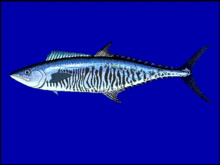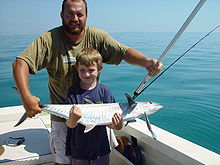- Narrow-barred Spanish mackerel
-
Narrow-barred Spanish mackerel. King Mackerel (South Africa) 
Scientific classification Kingdom: Animalia Phylum: Chordata Class: Actinopterygii Order: Perciformes Family: Scombridae Genus: Scomberomorus Species: S. commerson Binomial name Scomberomorus commerson
(Lacépède, 1800)Scomberomorus commerson, is a mackerel of the Scombridae family. It is found in a wide ranging area centering in South-east Asia but as far west as the east coast of Africa and from the Middle East and along the northern coastal areas of the Indian Ocean, and as far east as Fiji in the South West Pacific ocean. They are common down both sides of Australia as far south as Perth on the west coast and Sydney on the east coast. They are also found as far north as China and even Japan.[1]
Contents
Description
They are vivid blue to dark grey in colour along their backs and flanks that fades to a silvery blue grey on the belly. Spanish mackerel have scores of narrow, vertical lines down the sides. Spanish mackerel are the largest of all Australian mackerels growing to approximately 200cm and up to 70 kg.[2][3]
Distribution/habitat
It is found in a wide ranging area centering in South-east Asia but as far west as the east coast of Africa and from the Middle East and along the northern coastal areas of the Indian Ocean, and as far east as Fiji in the South West Pacific ocean. They are common down both sides of Australia as far south as Perth on the west coast and Sydney on the east coast. They are also found as far north as China and even Japan.
Life
Spanish mackerel spawn in oceanic conditions on reef edges. Eggs have a large oil droplet that aids in buoyancy and keeps them at the top of the water column which is warmer, well oxygenated and has an abundant planktonic food supply for the larvae once they are hatched. It is believed that when in the larval stage, Spanish mackerel stay in their own species-specific groups and are not normally found with other mackerel larvae species of the same genus, such as S. semifasciatus and S. queenslandicus. This is not always the case with adult mackerel where occasional mixing of different species within the same genus can occur.
Spawning is seasonal but it is protracted in the warmer waters of the tropics. Many of the fisheries that target this species are based on pre-spawning feeding aggregations. A significant proportion of the female fish caught in NT waters between July and December have either recently spawned or are close to spawning (Buckworth and Clark 2001). In general, spawning times for Spanish mackerel tend to be associated with higher water temperatures that promote optimal food availability for the rapid growth and development of the larvae (Jenkins et al. 1985). As the young larvae grow they move from the offshore spawning grounds to inshore and estuarine habitats where they are frequently found in the juvenile phase of their growth cycle. In the inshore environment they feed mostly on the larvae and juveniles of small fish and crustaceans until they become large enough to tackle small fish and squid (McPherson 1988). Australian studies of this species suggest that females are larger than males (McPherson 1992; Buckworth 1998; Mackie et al. 2003). Female Spanish mackerel mature at about two years of age or at around 80 cm in length. [4]
Feeding habits
Spanish mackerel are voracious, opportunistic, carnivores. As with other members of the genus, food consists mainly of small fishes with lesser quantities of shrimp and squid.
Fishing gear and methods
Spanish mackerel are a highly valued fish throughout their range in the Indo West Pacific. Recreational anglers catch Spanish mackerel from boats while trolling or drifting and from boats, piers, jetties, and beaches by casting spoons and jigs and live-bait fishing. Commercial methods are primarily run-around gill netting, and rarely, by trolling lures similar to those used by recreational anglers.
Some Common Names
Worldwide: Narrow-barred Spanish mackerel. South Africa: King Mackerel, Couta, Cuda. Australia: Narrow-bar, Narrowbarred mackerel, Snook, Spaniard, Spanish mackerel. USA: Barred mackerel, Narrowbarred mackerel, Striped Seer Arabia: Kanaad, Kanad or Kana'd
References

This Perciformes article is a stub. You can help Wikipedia by expanding it.

